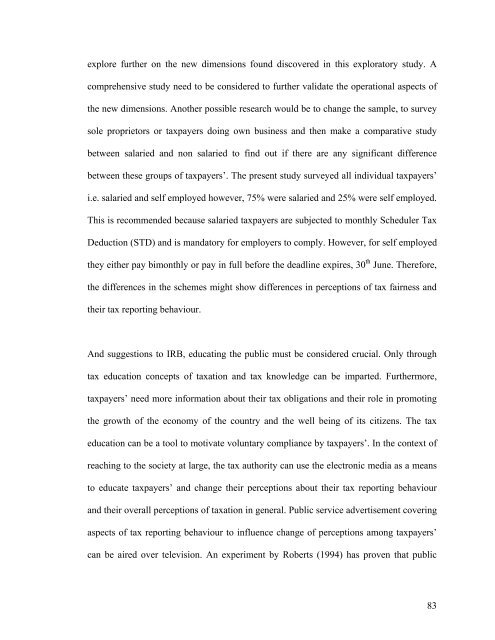1 CHAPTER 1: INTRODUCTION 1.0 Chapter ... - DSpace@UM
1 CHAPTER 1: INTRODUCTION 1.0 Chapter ... - DSpace@UM
1 CHAPTER 1: INTRODUCTION 1.0 Chapter ... - DSpace@UM
You also want an ePaper? Increase the reach of your titles
YUMPU automatically turns print PDFs into web optimized ePapers that Google loves.
explore further on the new dimensions found discovered in this exploratory study. Acomprehensive study need to be considered to further validate the operational aspects ofthe new dimensions. Another possible research would be to change the sample, to surveysole proprietors or taxpayers doing own business and then make a comparative studybetween salaried and non salaried to find out if there are any significant differencebetween these groups of taxpayers’. The present study surveyed all individual taxpayers’i.e. salaried and self employed however, 75% were salaried and 25% were self employed.This is recommended because salaried taxpayers are subjected to monthly Scheduler TaxDeduction (STD) and is mandatory for employers to comply. However, for self employedthey either pay bimonthly or pay in full before the deadline expires, 30 th June. Therefore,the differences in the schemes might show differences in perceptions of tax fairness andtheir tax reporting behaviour.And suggestions to IRB, educating the public must be considered crucial. Only throughtax education concepts of taxation and tax knowledge can be imparted. Furthermore,taxpayers’ need more information about their tax obligations and their role in promotingthe growth of the economy of the country and the well being of its citizens. The taxeducation can be a tool to motivate voluntary compliance by taxpayers’. In the context ofreaching to the society at large, the tax authority can use the electronic media as a meansto educate taxpayers’ and change their perceptions about their tax reporting behaviourand their overall perceptions of taxation in general. Public service advertisement coveringaspects of tax reporting behaviour to influence change of perceptions among taxpayers’can be aired over television. An experiment by Roberts (1994) has proven that public83
















